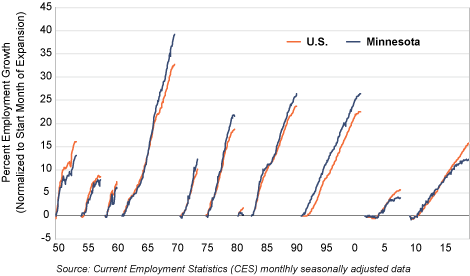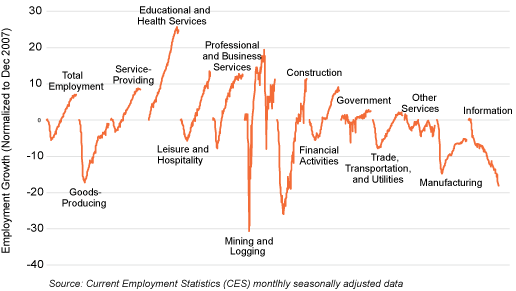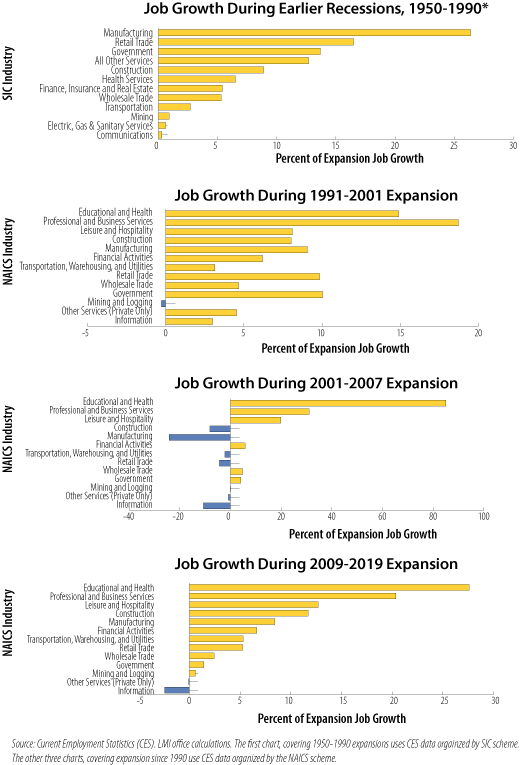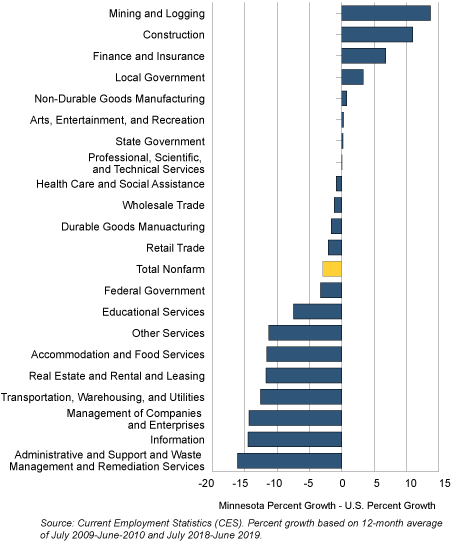
by Dave Senf
September 2019
Has Minnesota's employment lagged behind U.S. job growth because our labor demand is lower? Or is labor supply lower? That's the question.
In July, the current expansion, which started in June 2009, reached 121 months, moving past the 1991-2001 expansion as the longest of the 11 post World War II expansions. Despite its record length the ongoing expansion ranks in the middle of the pack when it comes to wage and salary employment growth in Minnesota and nationally (Figure 1).1 The largest percent job gain occurred during the 1961-69 expansion, which lasted 109 months, with employment climbing 39 percent in Minnesota and 33 percent in the U.S. Over the boom years of 1991 to 2001, when the state's unemployment rate reached a record low annual average rate of 2.7 percent in 1998, employment expanded by 26 percent in Minnesota and 23 percent nationally. In contrast, employment has increased just 12 percent in Minnesota and 16 percent nationally so far during the current expansion.

Many factors influence the rate of economic and job growth during expansions but one fundamental factor which comes into play as expansions lengthen and unemployment rates decline is the rate of labor force growth. The faster job growth during previous expansions and the slow job growth during the current expansion can to a large degree be explained by the entrance of the baby boom generation into the labor force in the 1960s and their exit over the last decade as they retire. Baby boomers are not the whole story. Labor force participation of men has been gradually falling over the last seven decades while the labor force participation of women, after gradually increasing for five decades, began to tail off around 2000. Another important ingredient to labor force growth over the last few decades has been the uptick in immigration to the U.S. and Minnesota.
Minnesota's job growth during the expansions in the 1950s was slightly lower than nationally. During the next six expansions, covering 1960 through 2000, job growth in the state was slightly higher than U.S. job growth except during the one-year expansion in 1980-1981. Minnesota's job growth over the last two expansions, including the current expansion, has lagged national job growth. The net result is that the state's share of U.S. wage and salary employment, after peaking in early 2003, has been slowly declining, pushing the state's share of national employment back to where it was in the early 1990s. Minnesota would have roughly 125,000 (or about 4 percent) more jobs if the state's share of national employment was still at the 2003 level. Minnesota had an estimated 105,000 unemployed workers in June, which implies that if Minnesota's job growth had matched national job growth the state would have an unemployment rate approaching zero if labor force participation held constant and immigration into the state didn't accelerate.
The million-dollar question is this: Has Minnesota's employment lagged behind U.S. job growth because labor demand is lower in Minnesota relative to the U.S. labor demand, or because labor supply in the state is lower relative to most other states' labor supply? Most indicators point toward Minnesota's relatively smaller pool of workers available for hiring as the most likely culprit rather than weaker labor demand. In 2018 Minnesota had the seventh lowest unemployment rate, the second highest labor force participation rate, the highest employment-to-population ratio and the fifth lowest U-6 unemployment rate. All these measures add up to Minnesota having a relatively small pool of potential workers compared to most states from which workers can be hired to fuel job growth. Minnesota companies have been raising the red flag about the lack of workers to fill jobs for years now. Labor shortages preventing business expansions may have indeed reached a critical level in Minnesota.
The three most recent expansions have generated 565,000 jobs (1991-2001), 104,000 jobs (2001-2007) and 320,000 (2009-2019). Roughly 91,000 (28 percent) of the jobs created during this expansion have been in the Educational and Health Care Services supersector (Figures 2 and 3). The Professional and Business Services supersector (20 percent) and Leisure and Hospitality supersector (13 percent) have added the next most jobs. The private-public sector split of employment growth has been 97.5 and 2.5 percent private versus public. The Service-Providing sector has accounted for 80 percent of job growth compared to 20 percent for the Goods-Producing sector. Goods-Producing employment is still below its pre-recession level as Manufacturing, which lost 50,000 jobs during the recession, has added only 30,000 jobs during the expansion. The Manufacturing workforce along with Other Services and Information workforces remain below pre-recession levels despite this expansion being the longest in duration. Structural (long-term) factors rather than cyclical (short-term) factors are behind the slow or negative job growth in these sectors.

Robust Manufacturing job growth used to be the norm during expansions as workers laid off during recessions would be hired back as expansions gained steam. Manufacturing hiring was the largest component of job creation during expansions prior to 1990, accounting for 26 percent of all job growth on average during the seven expansions between 1950 and 1990 (Figure 3).2 The robust hiring during expansions boosted Manufacturing employment above pre-recession levels during every expansion except for the last two. Globalization and offshoring of Manufacturing, as well as scarcity of workers, since the 1990s has limited the size of Manufacturing job rebounds in the last two expansions. Retail Trade and Government payroll expansions, unlike during more recent expansions, were the second and third largest source of job growth during earlier expansions.

The record length of this expansion has generated job growth across more sectors than during the 2001-2007 expansion. Eleven of the 13 sectors have added jobs since 2009 while only six sectors expanded payroll numbers during the 2001-2007 expansion. Manufacturing, Financial Activities, Transportation, Warehousing and Utilities, and Retail Trade have all added jobs during this expansion after having reduced jobs during the previous one.
Minnesota's slower than national job growth during the current expansion is spread across a number of sectors as only six out of 21 more-detailed sectors in Minnesota have added employment faster than their national counterparts during the current expansion.3 Mining and Logging jobs in Minnesota have climbed by 25 percent since 2010 versus 11 percent in the U.S. (the net difference is shown as 14 percent in Figure 4). Only three other sectors have had significantly faster job growth than the national rate: Construction; Finance and Insurance; and Local Government. Local Government employment nationwide has been flat over the last decade while increasing by 4 percent in Minnesota, with most of the job expansion coming in local government education in Minnesota.

Employment growth in eight Minnesota sectors over the expansion has been significantly slower compared to sectoral national job growth. It may be hard to believe given the number of eating places that have opened in the Twin Cities metro area over the last decade that job growth in Minnesota's Accommodation and Food Services sector since 2009 falls far short of growth nationally. But that is what the numbers show as Minnesota's Accommodation and Food Services sector employment expanded by 16 percent over the last decade compared to 27 percent nationwide. Administrative and Support employment has the largest Minnesota and U.S. job growth gap with jobs in this sector increasing by 14 percent in Minnesota and 30 percent nationwide over the expansion. The gap can mainly be traced to the 37 percent employment increase in the U.S. employee services industry (temporary help services) versus the 17 percent increase in Minnesota's employee services industry.
Figure 4 shows the Minnesota-U.S. job growth rate differences across sector over the current expansion. Figure 5 transfers sector (industry) employment to occupational employment and shows the Minnesota-U.S. occupational job growth rate differences across major occupational groups that occurred over the last decade.4 Two occupational employment data sources are shown, and the two sources don't always tell the same story for two reasons. One reason is that one source includes self-employment (ACS) while the other excludes self-employment (OES). The other reason is that ACS data comes from household (employees) surveys; OES data are based on employer surveys.

Both data sources report the same Minnesota-U.S. difference trend for slightly more than half of the major occupational groups. For example, job growth for Minnesota's computer and mathematical occupational group over the expansion has been 15 and 16 percentage points smaller than nationwide as reported by the OES (34 percent U.S. growth and 19 percent Minnesota growth) and ACS (37 percent U.S. growth and 21 percent Minnesota growth) data respectively. Jobs in construction and extraction occupations on the other hand have grown by 10 and 6 percentage points more in Minnesota than the U.S. according to OES and ACS data since 2009. For the other eight occupational groups the Minnesota versus U.S. occupational growth difference during this expansion is not distinctly apparent as the two data sources show conflicting relative growth.
Just as no two recessions are alike, no two expansions are alike either. The ongoing expansion in Minnesota has generated smaller job expansion relative to the U.S. than past expansions. Minnesota, along with other states with low unemployment rates and relatively slow job growth, is likely a harbinger of slower job growth across the U.S. as labor shortages spread across the country.
1Employment data used here is seasonally adjusted Current Employment Statistics (CES) data which covers non-agricultural wage and salary employment and excludes agricultural wage and salary and self-employed employment.
2CES employment data underwent a major overhaul in 2001 when the Standard Industrial Classification (SIC) system was replaced with the North American Industry Classification (NAIC) system. Average employment gains during the seven expansions before 1990 utilize the SIC system while the last three expansion utilize the NAICS in Figure 3. The two systems are not strictly comparable but are similar enough to show how the job growth during expansions has shifted across sectors.
3Figure 3 is based on CES average employment data for July 2009-June 2010 and July 2018-June 2019.
4Occupational employment data used in Figure 5 is Occupational Employment Statistics (OES) data for 2010 and 2018 and American Community Survey data for 2010 and 2017.